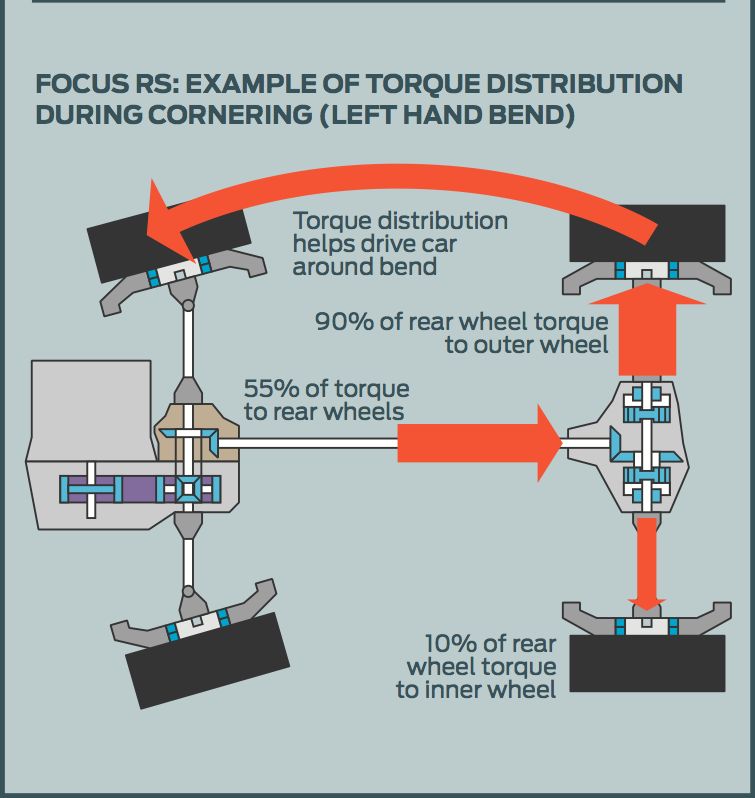Ford revealed the all-new Focus RS, a high-performance road car that debuts Ford Performance All-Wheel Drive with Dynamic Torque Vectoring Control. The all-new Focus RS is equipped with a new 2.3-liter EcoBoost® engine producing well in excess of 315 horsepower.
“The all-new Focus RS is a serious machine with high-performance technology and innovative engineering that sets a new benchmark for driving exhilaration on the road and track,” said Raj Nair, group vice president, Global Product Development, Ford Motor Company. “The RS line has a proud history of technical breakthroughs that have migrated to mainstream Ford vehicles to benefit all of our customers, and the new Focus RS is no exception. It’s a great example of our passion for innovation through performance, and creating vehicles that make people’s hearts pound.”
Ford Performance All-Wheel Drive system
The all-new Focus RS exploits innovative new Ford Performance All-Wheel Drive with Dynamic Torque Vectoring, combining improved traction and grip with higher agility and cornering speed compared to the previous Focus RS.
The Ford Performance All-Wheel-Drive system is based on twin electronically controlled clutch packs on each side of the rear drive unit. These manage the car’s front/rear torque split, and can control the side-to-side torque distribution on the rear axle – delivering the “torque vectoring” capability that has a high impact on handling and cornering stability.
The control unit in the rear drive unit continuously varies the front/rear and side-to-side torque distribution to suit the current driving situation, monitoring inputs from multiple vehicle sensors 100 times per second. A maximum of 70 percent of the drive torque can be diverted to the rear axle. Up to 100 percent of available torque at the rear axle can be sent to each rear wheel.
During cornering, the rear drive unit pre-emptively diverts torque to the outer rear wheel immediately based on inputs such as steering wheel angle, lateral acceleration, yaw and speed. This torque transfer has the effect of “driving” the car into the bend, achieving improved turn-in and stability, and virtually eliminating understeer.
The AWD system has been tuned to deliver better grip – with lateral acceleration exceeding 1 g. With neutral and adjustable limit handling, and the ability to achieve controlled oversteer drifts at the track, Focus RS delivers complete modular vehicle dynamics solution.
To deliver optimum driving dynamics, the Ford Performance All-Wheel-Drive system was calibrated alongside the car’s advanced Electronic Stability Control, in particular the brake-based Torque Vectoring Control system that works in parallel with the torque-vectoring AWD. Other chassis features include sports suspension with spring rates, bushings and antiroll bars – all of which are stiffer than those found in Focus ST, and two-mode switchable dampers, which offer a firmer setting for track driving. A tuned electric power-assisted steering system working in combination with a more rigid front suspension knuckle design and shorter-link arms delivers connected and responsive steering.
“The Focus ST and Fiesta ST showed that we can achieve sporty steering feel with an electric power-assisted steering system, and the RS raises the bar,” said Dave Pericak, director, Global Ford Performance. “We set out to provide drivers with steering that is very direct, precise and well balanced.”
Ford engineers worked closely with Michelin to develop a choice of high-performance 235/35 R19 tires to complement the driving dynamics of the Focus RS: a standard Pilot Super Sport tire for every-day use, and – for the first time on an RS – an optional Pilot Sport Cup 2 tire for enhanced vehicle dynamics on the track.
The vehicle’s exterior design has also been developed to support the dynamic objectives. Aerodynamic optimization of the front splitter, rear spoiler and underbody features eliminates lift forces.
The Ford EcoBoost 2.3l engine
Ford’s EcoBoost technology powers Focus RS and nearly every new Ford vehicle. Projected to produce 315 horsepower, the Focus RS unit shares its fundamental structure with the all-aluminum 2.3-liter four-cylinder engine in the all-new Mustang, but has been significantly upgraded through a package of design changes.
Increased output is generated by a new low-inertia twin-scroll turbocharger with larger compressor that delivers higher airflow, along with a much bigger intercooler to maximize charge density. Engine breathing is enhanced through a less restrictive intake design, and a large-bore exhaust system with an electronically controlled valve in the tailpipe that helps optimize the balance of back pressure and noise output.
The cylinder head is produced from an upgraded alloy material capable of withstanding higher temperatures, and is mounted on a more robust head gasket with improved thermal capability. The cylinder block employs stronger high-tensile cast iron liners.
Engine cooling also has been given the highest priority, with engineers creating additional space within the front of the vehicle to house a significantly larger radiator pack that provides the level of cooling demanded for hard circuit use.
Calibration work ensures that the power unit delivers low-end responsiveness with a powerful mid-range pull, climbing up to a maximum rev limit of 6,800 rpm.
The six-speed manual transmission has been optimized with a shorter gear lever to deliver faster and more accurate shifts. Both the transmission and the clutch have been upgraded with stronger components to cope with the engine’s increased torque output.
With its EcoBoost design featuring direct fuel injection, twin independent variable camshaft timing, advanced turbocharging and Auto Start-Stop as standard, the engine also delivers significantly improved fuel consumption.




















